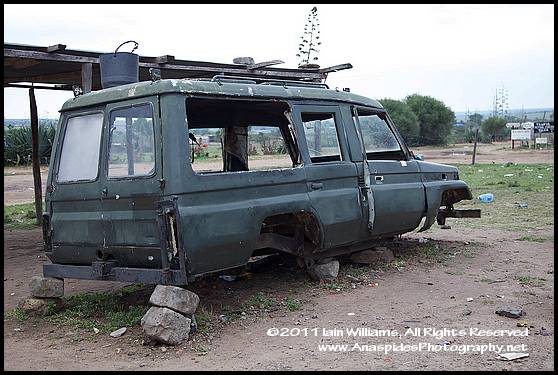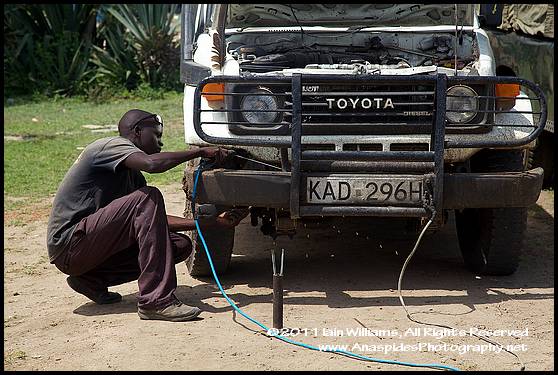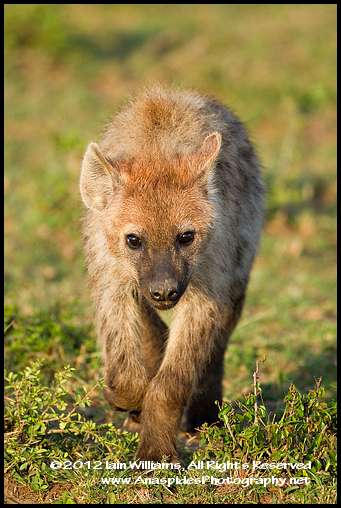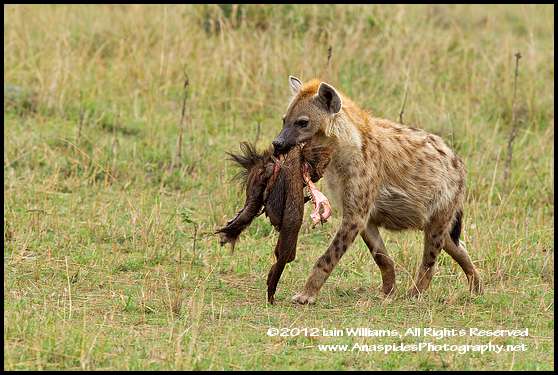If I hear this comment one more time I’ll scream….
Five weeks in Africa self drive can be very damaging to a motor vehicle, more so if you have an off road permit. In Australia I own a Toyota Landcruiser which is an excellent vehicle and takes me to some out of the way places, but my vehicle is regularly maintained. The rental vehicle in Africa was Toyota Landcruiser troop carrier. In many respects a similar vehicle with the exception that this four wheel drive hadn’t been regularly maintained.
 Australian Landcruisers Are Tough
Australian Landcruisers Are Tough
The lineage of this vehicle was Australian and it had been purchased second hand from Telecom, the Australian communications company. On the outside the 4X4 looked OK, and for the first week or so performed admirably. But as time passed, problems began to present themselves.
LEFT: Field repairing the front left spring which began to break due to rough road conditions. Masai Mara warriors watch as we work!
Apart from the usual flat tyres and getting stuck a few times in deep mud, we had more insidious issues. The front springs were makeshift and had been replaced incorrectly; we were afraid that with the workload they would fall apart leaving us stranded in “lion country”. Further, the roof hinges for the observation roof were damaged and rattling like chattering teeth and the attachment points of the bulbar to the chassis were loose due to poor welding. Shock absorbers were – well let’s say they didn’t absorb anything at all! But we continued using the vehicle until the inevitable occurred.

LEFT: We wondered if "this" would be our Toyota in a year or so!
Mechanical Problems
BANG – while driving along the dirt track, the hinges of the roof hatch broke and the heavy metal hatch flew forward onto the bonnet (hood) of the Landcruiser. It then hit the bull-bar which reflected the hatch back towards the windscreen – SMASH. In 30 seconds the windshield was cracked and the hatch was lying loose. Repairs were necessary so we drove to the nearest town and mechanical repair facility. The name “repair facility” is erroneous, as these guys were not mechanics but locals who knew a little bit about mechanics – just enough to be dangerous. They repaired the car for a few  dollars and away we went satisfied that all was OK.
dollars and away we went satisfied that all was OK.
LEFT: Field welding the bullbar back to the vehicle chassis.i
A few days later, BANG!! We hit a hole in the ground and the vehicle lurched precariously to the side. Inspecting the damage it was noted the bulbar now had fallen off the car, the rear tyre carrier had also broken away and the shock absorber – well what shock absorber! It was gone. Another visit to our newly made mechanical friends soon rectified the situation – for a few dollars. The locals shrugged off our comment about regular maintenance, log books and the like – “Hey this Africa” they chanted.
As we departed the repair facility, we could only wonder if this was going to be a regular affair. A few days later as we crossed a rather deep and rocky river crossing – BANG!! The vehicle sunk to the chassis in the centre of the river. Our first thought was crocodiles, but there were none nearby. We literally smashed the transmission repeatedly into forward and reverse as we attempted to extract ourselves from the hole. BANG!! Was that the drive shaft or the front diff hitting a submerged rock– who knows! Climbing from the river we inspected the vehicle again. The front springs were not looking healthy! Further, the steering was suspect as the car veered sideways when driving. Time to say hello to our local friends again and here the ominous words “Hey this is Africa” as we parted with a few more dollars….
This visit identified additional mechanical issues. As we drove into the town locals jumped about and wildly pointed at the front wheels. Alighting from our chariot to inspect the front wheels we were “delighted” to see that the right hand tyre was sitting at a crazy angle!! The upper bearing had broken and wheel was about to vacate the car!
 Authorized Toyota Repair Facility – Ahhh No
Authorized Toyota Repair Facility – Ahhh No
It soon became apparent that this was NOT an authorized Toyota repair facility as we watched the bearings being replaced. The bearings were striped apart and placed on the sand – YES read sand. They were then cleaned with petrol by a young African smoking a cigarette (I stood well away). New grease was not applied to the bearings but rather they used the older sand-entrained grease. When I mentioned this to the head mechanic, he quickly smeared some new grease over the older grease looking at me with a smile that said “Hey this is Africa”….. A few dollars and once again we were on our way!
The final straw was a few days later when we hit a rather large hole whiles travelling off-road. BANG!! Inspecting the car we noted more issues which included the front springs looking slightly “more” bent than what they were a week earlier. We drove on but stopped when we noticed we no longer could hear a rattle that had been present for two weeks. To our horror we found out why there was no rattle; the sidebar, which was the cause of the rattle, had vanished! It must have fallen off on one of the river crossings! We looked or the sidebar but never found it.
 The vehicle served us for three weeks. It was then decided, in lei of the amount of time being spent having the vehicle repaired, that it was prudent to rent another vehicle form Nairobi with a driver. After this decision, our repairs ceased and although the local mechanics waved to us every time we passed through town, we never did stop to hear the words “Hey this is Africa” again.
The vehicle served us for three weeks. It was then decided, in lei of the amount of time being spent having the vehicle repaired, that it was prudent to rent another vehicle form Nairobi with a driver. After this decision, our repairs ceased and although the local mechanics waved to us every time we passed through town, we never did stop to hear the words “Hey this is Africa” again.
LEFT: Field repairs were a constant ordeal and we were always keeping an ear to the ground listening for something else falling off, or breaking on the vehicle. Tyre repairs and changes were common and in "lion country" need to be done as quickly as possible, Here a Masai Mara warrior lends a hand to Uwe as a damaged tyre is replaced.
Other Issues
Of course if the above mechanical issues were not enough to keep us on our toes, there were also battery problems. The battery was new but the wires and alternator were old - very old! I have SOG to thank for making a very robust knife tool (like a leatherman). I used this on several occasions to repair the alternator and arc the battery terminals so the car would start! I can remember at one stage we all were pushing the vehicle in an attempt to clutch start it, but it got away from us and started chugging along the track without its passengers; We were madly running after the car!! An except from the movie flick "The Gods must be Crazy" crept into my mind as I clamored aboard.
But, as they say "this is Africa"...
 Monday, March 19, 2012 at 4:15PM
Monday, March 19, 2012 at 4:15PM 











